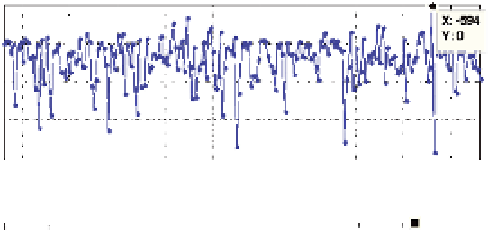Global Positioning System Reference
In-Depth Information
PRN Elevation (
o
)
C
/
N
0
(dB-Hz) Code-phase (chips)
f
D
(Hz)
r
D
(Hz/s)
30
60
-
180
-635.0
-0.4
6
73
32.7
120
1067.5
-0.5
Table 4. Assistance log, indoor, Rb
(chips)
f
(
pred
)
D
τ
(
pred
)
PRN
Aiding source
(kHz)
6
FFT
1000.3
1.1
30
Assistance server 1060.3 or 37.3
-0.6025
Table 5. Aiding data, indoor, Rb
Fig. 11. Long coherent correlation, indoor, Rb,
T
int
=
2000 ms, PRN30
of the this signal (GalileoICD, 2008) includes data (B) and pilot (C) channels which are
multiplexed by Coherent Adaptive Sub-carrier Modulation (CASM) (Dafesh et al., 1999). Each
channels shares 50 % of the total transmitted power.
To represent this signal, the common
representation in (1) is changed to
√
2
√
2
C
1
r
[
n
]=
(
d
[
n
+
τ
]
b
[
n
+
τ
]
−
c
2
nd
[
n
+
τ
]
c
[
n
+
τ
])
cos
(
2
π
(
f
IF
+
f
D
)
nT
S
+
φ
) +
n
W
[
]
(49)
n
[
]
[
]
b
are respectively the 4-ms primary PRN codes of the data (B) and pilot (C) channels
modulated by BOC(1,1) scheme;
d
n
,
c
n
[
n
]
is the navigation data in the B channel;
c
2
nd
[
n
]
is
the secondary code, which together with
c
form a 100-ms tiered code for the C channel
(GalileoICD, 2008). Basically, the conventional acquisition stage in Fig. 1 can perform on
either B or C channels. This strategy is referred here as Single Channel (SC). However, SC also
implies a waste of half of the real capability. Therefore, joint data/pilot acquisition strategies
are introduced to utilize the full potential of the E1 OS signal (Mattos, 2005; Ta et al., 2010). In
the followings, these strategies are described together with the performance evaluation.
[
n
]









































































































































































Search WWH ::

Custom Search